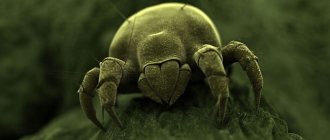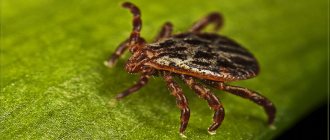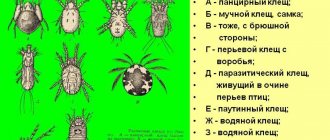Are ticks dangerous for humans in winter?
In most regions of Russia, ticks are not active in winter, and encounters with them can only occur in exceptional circumstances.
Most often this happens when a tick enters the house in the summer - on clothing or some objects. Sometimes victims of winter bites bring ticks from foreign trips to warm countries. Since the most dangerous viruses and bacteria are carried by these mites, it is simply necessary to send the parasite for laboratory analysis in this case.
Under unfavorable conditions, ticks disappear, going into hibernation with the onset of cold weather. Thus, the danger of being bitten by a tick in winter in central Russia is practically zero.
Methods of protection against ticks
The best way to protect yourself from blood-sucking parasites is not to go into the forest and spend the period of tick activity at home. This, of course, is not an option. Therefore, you need to prepare in other ways:
- clothing should be tight and closed;
- pants should be chosen with elastic at the calves so that the tick cannot crawl further;
- the jacket should be thick, also preferably with an elastic band at the wrists;
- shoes - high and closed.
Another important point is that you need to constantly inspect your clothing for ticks already attached. They are more visible on light-colored clothes, so it is recommended to choose a wardrobe in light colors.
Avoid wandering into dense grassy areas and stick to well-trodden paths and paths.
Precautions against tick bites
Winter activity of forest ticks in different climatic zones
Resistance to cold in different types of ticks depends on the area of their permanent habitat. In Russia, the northernmost region where these parasites live is the coast of the Barents Sea. Populations living in this area often cannot find food for themselves throughout the summer and hibernate again.
In Siberia, the distribution and survival of ticks are associated with the stability of the snow cover and the level of thermal insulation of the forest floor.
In central Russia, ticks choose for wintering areas with secondary forest plantations and edges with dense bushes.
In the south of the country, parasites hibernate for only a short time, using the burrows of small vertebrates or voids underground.
Winter activity
A decrease in air temperature always negatively affects the activity of parasites, since they are not able to maintain a constant body temperature. A signal for hibernation is also a reduction in daylight hours and a change in relative air humidity.
Under unfavorable external factors, parasites enter a special state - diapause, which allows them to safely survive the winter. In central Russia, the seasonal activity of parasites ends at the end of October.
Interestingly, hungry individuals of all developmental phases turn out to be more resistant to negative temperatures. In well-fed ticks, cold resistance is reduced due to processes associated with metamorphosis and molting after feeding on blood. Females engorged with blood are unable to control their reproductive processes, and their eggs, not having sufficient cold resistance, usually die by 99%.
In the spring, hibernating ticks wake up. In mid-latitudes, adult individuals become active already at a temperature of +3... + 50C, showing the greatest activity in places well warmed by the sun's rays.
Manifestation of winter diapause
As the air temperature decreases, the activity of ixodid ticks also decreases. A slow metabolism and good protection from the cold helps them to easily survive unpleasant weather conditions in the life cycle in which they were caught by the cold. Pests do not need food, they simply freeze until the weather warms up.
Ticks
For normal wintering, ticks need the following conditions:
- air temperature is not below zero;
- high humidity.
Ticks die instantly at a temperature of minus 15°C; in coniferous forests, parks and squares without the proper thickness of leaf cover and the complete absence of grass, they die within a few hours. Those who have survived the cold in favorable conditions become active with the first rays of the sun; already at +3°C they will look for a victim for further life activity.
Global warming has a positive effect on the reproduction and spread of ticks; heat and high humidity increase the period of their activity, which allows females to lay more eggs. The process begins in the first months of autumn, when the weather gets slightly colder, the females, having previously refreshed themselves, look for a favorable place to lay eggs. Basically they choose:
- ravines with a lot of rotted leaves;
- thickets of tall grass;
- thicket of the forest.
If in the future the air does not warm up to sufficient temperatures, the larvae hatched from the eggs will remain at this stage of development until spring.
Peculiarities of wintering of ticks at different life stages
The life cycle of ixodid ticks consists of several phases: eggs, larvae, nymphs, adults. With rare exceptions, they all go through the wintering stage.
Hungry females are most resistant to cold. They can stay at sub-zero temperatures for a long time without harm to vital functions. Fed larvae are most vulnerable. They die after 3-5 days if the thermometer drops to -7...-10 degrees below zero. Hungry larvae and engorged nymphs cope with sub-zero temperatures more confidently.
The female dies in the fall while laying eggs, which continue to remain in her body and only emerge in the spring as larvae. The larva is already ready to feed on the blood of animals and people. During this period, she transforms into a nymph, after which she falls into hibernation. In spring the nymph is active again. Having had enough, it hibernates again, only to turn into an adult insect after waking up.
After another wintering, fertilized females complete their life cycle by laying eggs. Males die after completing the fertilization mission.
Eggs
If bitten by a tick. First actions
About 13% of ticks can infect humans. But if you do find an insect on yourself or a pet, it is visually impossible to determine whether it is dangerous or harmless. After removing the insect's body from the wound with a rotating motion, make sure that there is no head left inside. Otherwise, the infection will continue.
Within 24 hours after the bite, an immunoglobulin injection should be given there, which will serve as a prophylaxis against encephalitis. If more than 48 hours have passed since the bite, the injection is useless. The medicine is administered intramuscularly, as prescribed by the doctor, who selects the dose of the drug individually.
If time is lost and it is impossible to conduct an examination of the tick that bit you, then after 3 to 4 weeks you should take a blood test to make sure there is no disease.
Not every tick is infected, but the possible danger should not be underestimated. With timely medical care, even an infected tick will not cause harm or it will be minimal. If it is not possible to promptly contact a medical facility, the tick must be removed on your own. When removing a parasite, it is important to not allow the parasite to rupture.
Devices for self-removal of ticks are available in the form of plates with a drop-shaped hole and spoons or hooks with a V-shaped slot. The embedded tick must be pryed as deep as possible under the head and carefully pulled out using twisting and rocking movements. All tools are small in size and can be used as key rings. Products available include Tick Twister and Trixie hooks, Ticked Off spoon, Pro-Tick and Tick Key plates.
Tick removal hook
The Tick Remover, which is similar in principle to a collet pencil, deserves attention. Among the domestic tools we can name tweezers for removing ticks Anti-Mite. Anti-Mite differs from ordinary tweezers in its triangular working part made of wire, which is convenient for capturing the parasite. The principle of operation is the same: the tick is grabbed as close to the head as possible, swings and turns outward.
In the absence of special tools, you can use ordinary medical tweezers, but in this case the risk of tick rupture increases. The original method is to extract the parasite using a regular disposable syringe. The cylindrical part of the syringe is cut off from the side where the needle is attached, the resulting hollow cylinder is pressed tightly to the bite site so that the tick is inside. After this, the piston is pulled out, and the spider jumps out under the influence of vacuum.
The most well-known method is to remove the tick using a harsh thread or thin rope. The insect must be wrapped in a loop, loosened and carefully removed, continuing to swing from side to side. The method of removal using oil is considered dangerous; doctors are categorically against its use.
The removal principle is based on the assumption that if you drop oil on an embedded parasite, it will begin to suffocate and crawl out of the wound on its own. This is not to say that this is impossible, but first the tick can regurgitate inside the person everything that it managed to suck out. It is possible that the spider will simply suffocate and die, remaining in the body.
If extraction was unsuccessful and the head remained under the skin, it must be removed with a disinfected needle. After extraction, in any case, the wound is treated with iodine, alcohol (vodka) or another disinfectant solution. The extracted tick must be submitted to a laboratory for testing.
In order to protect against ticks in places where they may live, it is necessary to wear tight clothing that covers all parts of the body. A headdress or scarf is required. Ticks live at a height of about 1 m above ground level; falling from above rarely occurs. The parasite can also attack from the ground, and does not immediately bite into it.
He begins to climb up in search of a comfortable place. It can take several hours from the moment of contact with the body to the bite, so after returning home you need to carefully examine not only your body and your pet, but also your clothes. Particularly attractive areas for ticks are the armpits, groins and neck. A tick bite is painless.
The right clothes for the forest
Among the medical means for protection we can recommend:
- repellent (repellent): Gall-RET, Deta-WOKKO, Biban, Reftamid maximum, Off! Extreme, DEFI-Taiga;
- acaricidal (killing): Reftamid taiga, Tornado-Antiklesch, Fumitox-anti-mites, Permanon, Piknik-Antiklesch, Gardex aerosol extreme;
- complex (repellent and killing): Kra-rep, Mosquito-anti-mite.
Correct actions will prevent a tick bite, and even if this happens, it will allow you to avoid serious consequences.
Where do ticks hide in winter?
It is also interesting how the tick overwinters. The parasite remains at the stage of development at which it was in the fall.
Ticks choose for wintering places where snow lies for a long time and is not blown away by the wind. They hide in leaves and grass, where the temperature does not drop to sub-zero levels. During decomposition, the remains of vegetation release a certain amount of thermal energy, providing the necessary conditions for overwintering of ticks.
In winters with little snow, up to 20-25% of overwintering ticks die in nature.
How do ticks overwinter?
The body of ticks has a special self-regulation system that allows them to fall into suspended animation during the onset of cold weather. It is thanks to this analogue of hibernation that insects can wait out the winter and become active again with the onset of warmth. How do ticks overwinter and where do they hide?
The hibernation process itself proceeds as follows:
Depending on the species, a tick can live in this mode from 4 to 8 years. Both tick larvae, which look the same as adult insects, but are smaller in size, and adult individuals can fall into suspended animation.
The places where ticks most often overwinter are:
The tick covers itself with plant humus, similar to how people wrap themselves in a blanket. Falling snow additionally protects the pest from wind and frost throughout the winter. Its life depends on how well the parasite chooses a place for wintering and how well it protects itself with available means. Not all ticks that hibernate for the winter necessarily wake up next spring. If the place was chosen poorly, the cold will kill the tick in its sleep.
The percentage of ticks that survived and died during the winter may vary depending on how snowy, cold and windy the winter was, but absolutely all ticks cannot die in the cold in Moscow or the Moscow region, there will definitely be survivors and there will always be more than enough of them to with the onset of spring, they will again begin to harm people and animals.
It is precisely because of the life cycle of ticks and their predisposition to certain weather that the most effective and safest for people is the treatment of summer cottages and any open areas in early spring and late autumn.
Disinfestation of a site using professional means can also be carried out urgently, at any time convenient for you, when the ground is not covered with snow.
Optimal conditions for wintering ixodid ticks
When discussing how ixodid ticks winter, it should be noted that the optimal temperature for their wintering is about zero degrees. This also requires a sufficiently high air humidity. In the conditions of central Russia, their survival is possible only with stable snow cover.
Ticks can spend the winter well in the burrows of small rodents, sometimes managing not to even go into diapause and continuing their active lifestyle, parasitizing the hosts that shelter them. Often in the spring such mites still live on these vertebrates.
When are ticks especially active?
Ticks “wake up” and become most active when the first warm days after winter arrive. If the soil has warmed up to 5 degrees, we can assume that the peak of parasite activity has begun. Regardless of the regions in Russia, the most dangerous months for visiting forests and forested park areas are April (from the very beginning), May and June. It is during this season that mass mating and reproduction of ticks occurs, when they especially need “feeding” in the form of blood.
It is important that tick activity is not so much a calendar phenomenon (clear time limits for activity cannot be established) as a weather phenomenon. Warm (from 7 to 22 degrees) days and sufficient humidity (preferably about 80%) are the ideal time when ticks feel comfortable. This is the average temperature that is maintained in Russia during the period from the second half of April to June. Ticks do not like extreme heat and cold, so their activity at this time is somewhat lower. But before the rain, when it’s not so hot and the humidity is just right, going into the forest is fraught with consequences.
In addition to the May period, there is also a second peak in the fall - in August-September. However, few people think seriously about it, since this period is not so dangerous for several reasons:
- Most ticks are already full; their reproduction process takes longer;
- the number of parasites has noticeably decreased thanks to birds happily feeding on ticks.
In general, regardless of the stage of development of ticks, it is quite possible to be attacked by them in the period from April to October, the main thing is that the weather is suitable. If the spring is early, ticks become active earlier; if the Indian summer is prolonged, the parasites will not go to winter for a long time. This is especially noticeable in taiga regions and forest climatic zones.
If we talk about the time of day when ticks are more active, then it is morning (around 8-9 hours) or evening (19-22 hours).










